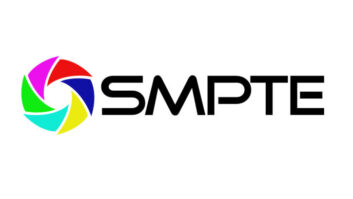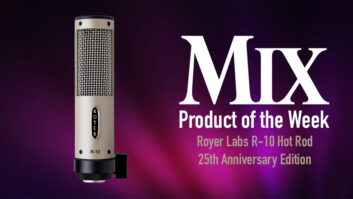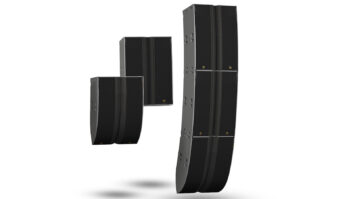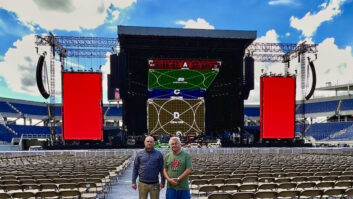
It’s clear from the recent history of the entertainment businessthat the public’s appetite for the past is no less voracious than itscraving for the new. This is obvious not just from the recent spate ofmovies based on the TV fare of yesteryear, or the theatrical re-releaseof classics such as The Wizard of Oz and Touch of Evil. Consider alsothe tremendous boom the music industry has enjoyed by reissuingyesterday’s records as today’s CDs, and the home video industry’slucrative trade in movies long since gone from theater screens. Andeven in “new media,” where the mantra “content is king” has mercifullyfaded from overuse, the marketability of existing entertainment assetsremains unquestioned.
Unfortunately, just as the economic value of existing content is nowtaken for granted, so too is the notion that the material will alwaysbe around, ready and waiting for reuse. Yet much of thismaterial-prized by some for its profit potential and others as culturalhistory-has already exceeded all reasonable expectations for thelongevity of its original medium. In the early days of audio tape, forinstance, the emphasis was on achieving acceptable performance ratherthan preserving posterity, and few could predict the long-terminteractions of the component materials used. Many original recordingshave survived remarkably well, but countless others are eitherpartially compromised or permanently damaged.
The solution to the preservation problem is two-fold: transfer oldertapes to new stock-hopefully in a transparent, high-fidelityformat-while at the same time stabilizing the condition of originalmasters through proper storage techniques. The fundamentals ofretarding deterioration are well-established, though frequentlyoverlooked. Oozing splices are replaced, hopefully before they stick toand tear off adjacent layers of oxide. The tapes are packed offtails-out with a smooth, even wind. And the masters are stored in astable environment of cool, dry and clean air.
The storage step is the one that concerns us here. Whatever theirmerits as centers of recording activity, cities like New York, LosAngeles and Nashville are rarely thought of for their archival-qualityair. In fact, it is doubtful that the climate of any spot on Earthmeets year-round the ideal of low temperature and low humidity. Sostoring precious masters down in the cellar, up in the attic or underthe bed-or even in a typical air-conditioned office environment-is notrecommended. Nor is a locker down at the local self-store. The bestplace for masters is in a facility specifically climate-controlled withlong-term storage in mind.
MASTER CONTROL The major labels are no doubt aware of the preferredstorage conditions for their tapes; the extent to which each has actedon this awareness varies according to its wisdom and resources. Butwhat of the vast and varied collections of tapes that are in individualhands, or that sit in recording studio storage rooms, forgotten soonafter the album is released? With more and more artists retaining orregaining control of their masters, the need for facilities to preservethose masters for the long haul is growing.
The trend toward greater artist and producer control has worked outwell for David Wexler, owner of Hollywood Vaults, a storage facility hedesigned from the ground up for long-term preservation of film(photographic and motion picture) and tape (audio and video). The musicindustry in general may be less educated about the need for properstorage than the film and video industries, where, Wexler says, “theneed for appropriate storage is a given.” Even so, he estimates thatabout 50% of his business is now music industry-related.
Wexler started Hollywood Vaults in 1985, after an initial foray intofilmmaking left him looking for a more entrepreneurial outlet for histalents. Over the years he has acquired a broad array of professionalaffiliations in his field, ranging from SPARS, SMPTE, American FilmInstitute, Technology Council of the Motion Picture-TelevisionIndustry, Society for the Preservation of Film Music and Associationfor Recorded Sound Collections on the one hand, to Society of AmericanArchivists, Material Handling & Management Society, Self-ServiceStorage Association and American Society for Industrial Security on theother. In addition to operating Hollywood Vaults, Wexler is a designconsultant to clients such as Walt Disney Studios, Paramount Pictures,Sony Studios, Technicolor Film Laboratory, CORBIS, Eastman Kodak Co.,Steven Spielberg Foundation and Pearl Jam.
Because confidentiality is one of the fundamentals of Wexler’strade, the names of Hollywood Vaults’ own clients are not publiclydivulged. But a recent tour of the facility confirmed that they includesome of this century’s top names in entertainment (or their estates).In one vault you can see master tapes of albums by Platinum-sellingrecording artists, in another stacks of photo boxes containing imagesof some of our era’s most important political and social figures, andin a third reels of film from early movie comedy pioneers. To emphasizehis clients’ stature without revealing their identities, Wexler hasfigured out that between them they have received more than 200 Oscars,Grammys and Emmys.
“Our record industry clients,” Wexler says, “tend to be artists andproducers who like to keep on top of their masters, to keep track oftheir own media assets. The labels should keep their collections inconditions like this, but often they don’t. So it tends to beindividuals who really care about their original materials. Andproducers are very often the ones that are in the best position togather everything together, prepare it for storage, and make sure itgets put in an appropriate place.” Wexler says he is working with theMusic Producers Guild of the Americas to spread the word about tapepreservation technologies.
Hollywood Vaults is obviously not the only facility catering to thestorage needs of the entertainment industry. But Wexler is eager topoint out some of the differences in approach between his facility andthose of many of his competitors. “Most of the other places are notpurely storage operations, but also delivery services. You call them upwhen you need a particular item, and if they are open, they bring itover to you. If not, you have to wait. And the materials themselves aregenerally stored in large, open warehouses. Everybody’s stuff is alltogether, which can raise some concerns about security.”
Wexler decided to take a different approach, based on theself-storage model but with an environment tailored for film, tape,photos and digital media. Hollywood Vaults offers no pickup or deliveryservices. Instead, each client has 24-hour access to a storage areacontaining only their personal materials. And while Hollywood Vaultscan provide information and put clients in touch with professionalarchivists or librarians, the company does not directly aid clients inorganizing or preparing their materials for storage.
WEXLER’S WORLD What is most interesting about Hollywood Vaults as apotential model for record industry storage facilities is the buildingitself and the environment Wexler has created within it. Thepurpose-built structure on a quiet Hollywood side street was atcapacity within two years of opening, leading him to undertake anexpansion, completed in 1997. The addition maxed out the current siteat 13,500 square feet, and left the $4 million facility about 70%full.
It is evident from the moment one arrives on the premises thatWexler has thought out every detail. Primary access to the building isthrough a secure ground-floor parking area where clients can load andunload materials at their leisure; a compressed air hose hangs nearbyfor blasting dust off of boxes before they are brought in. As you steptoward the entrance, frosted glass panels glide back with a swishreminiscent of doors on the Starship Enterprise. Passing through adownward airflow that creates a barrier between inside and out, youenter a realm of gleaming glass, sparkling stainless steel, and glossywaxed linoleum floors set off against matte-gray cinderblock walls.Crisp, quiet and spotless, it feels wholly removed from the urban gritof the world outside.
The bulk of the facility’s storage space is found in five main vaultrooms, where high-density mobile shelving units may be cranked left orright to open up aisles for access to individual storage areas. Thevertically adjustable shelving is two feet deep and either eight ornine feet high. Rented on a monthly basis, spaces are available in sixsizes with total shelf widths ranging from 6 to 42 feet. A 6-foot”aisle vault,” Wexler estimates, has room for about 850 10-inch reelsof half-inch tape, while the 42-foot “double vault” could handle some7,000. For less extensive collections, Wexler offers “media safes” and”media lockers” ranging from one to 13 cubic feet. And for truecold-storage of film and negatives, there are three “cryogenic freezerunits.” (The chilling of living beings for future revival isdiscouraged.)
Wexler maintains the vault rooms at 45degrees Fahrenheit and 25%humidity, conditions he says are optimum across the whole range ofmaterials at the facility. The low humidity, he points out, isparticularly important for audio tape formulations that are prone tohydrolysis (also known as “sticky shed” syndrome), in whichpolyurethane in the tape’s binder absorbs atmospheric moisture, causingurethane molecules to migrate to the surface and gum up the tape pathduring playback. “At the least,” Wexler says, “low humidity willprevent or slow that process by keeping the binder dry. But there isalso some evidence suggesting that over time, very dry air can actuallydry out the tapes, making them playable again, and eliminating thetime-consuming, costly and potentially damaging process of baking thetapes before transfer.”
Each of the vault rooms is equipped with carbon and particulatefilters to remove contaminants from the air. Additionally, the fifthand newest room features “molecular sieve” filters to combat the”vinegar syndrome” that plagues “mag,” the oxide-coated film used inaudio production for movies. “The acetate base film used in mag,”Wexler explains, “is a natural product made from cellulose acetate,which was originally cotton. As the mag ages, moisture and heat andiron in the oxide can cause the acetate to break down, which releasesacetic acid (which smells like vinegar). Eventually the film basebreaks down. It deteriorates, shrinks and becomes deformed, whichcauses the oxide to fall off. So in many cases the sound elements for afilm present more of a preservation problem than the motion picturefilm itself.”
HAZARDS AND SECURITY While Hollywood Vaults’ temperature andhumidity systems are sufficient for most of the media types that comethe company’s way, there is one type of material that Wexler does notallow on premises: silver nitrate films, which are known to be highlyflammable under certain conditions. The entire building is concrete,and Halon fire-suppression systems are installed throughout. But thefacility is not set up to handle such films properly, and even if itwere, the presence of such material would undermine one of the primaryservices the company offers its clients: the security of knowing theirvaluable assets are safe from harm.
For the same reason, Wexler does not maintain a backup generator:Storing a tank full of diesel on-site, he reasons, poses a potentiallygreater risk than does loss of power to the air conditioning anddehumidifying systems. “The vault rooms will hold their temperature andhumidity for several days without power,” he says, “as long as there isnot a lot of traffic in and out. Even if there is a natural disastersuch as an earthquake that keeps the power off, I wouldn’t expect tosee a lot of people rushing to the vault to pick up their tapes.” Othersystems such as lighting, security and access control are kept inoperation during power outages by battery backup. And as for overallstructural integrity in a quake, Wexler says the building is designedfor a load of 450 pounds per square foot, nine times the seismicrequirements.
If natural disasters are not much of a concern, what about a humanhazard such as theft? It takes several successive stages of PIN-codecontrolled entry-the garage door, the main entry, the vault room andthe individual vault-to get to the goods. Because Wexler can easilychange the PIN-codes, former employees or clients can be immediatelyremoved from system. And Wexler is on premises most weekdays, keptcompany in his office by 20 TV monitors fed by security cameras locatedinside and out. “A security patrol checks the building nightly,” headds, “and the facility is monitored by a central security station 24hours a day for heat, smoke, fire, flood, temperature, humidity andintrusion.”
It is clear from a tour of Hollywood Vaults that Wexler is devotedto detail, from the spit-polish of the floors to nice touches likejackets (it’s cold in those vaults!) and work areas for clients(complete with phone, fax, Internet access and label makers). Thoughthe facility does not represent the only viable approach to media assetstorage, it certainly seems to be a model worthy of consideration bythe record industry. (For a virtual tour, go towww.hollywoodvaults.com.) Hollywood Vaults and others in the field haveshown how long-term preservation of original materials might beachieved, but without more in the music business following their lead,much of our recorded musical heritage may still be heading for a slowfade to silence.







